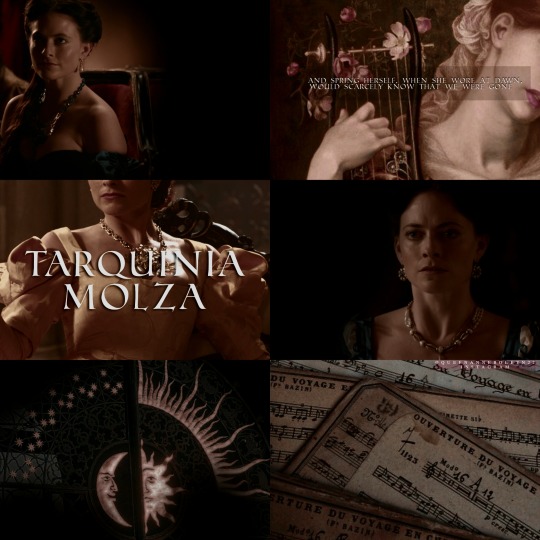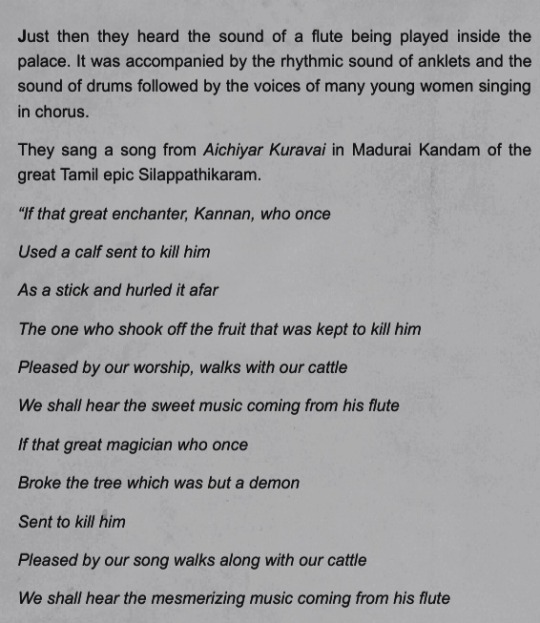#16th century composers
Text

first part of a maglor themed triptych
#silm#silmarillion#maglor#i haven't actually drawn him in armor much#i ended up designing a new set for him based off real-life 16th century german armor#bc for some reason maglor's regular clothes ended up with a weird 17th-18th century german composer aesthetic#and that ended up carrying over to his armor design
106 notes
·
View notes
Text

Poet, musician, composer, classical scholar, philosopher, astronomer, mathematician—Tarquinia Molza inspired admiration not only for her agile intellect but for her independent spirit. Born into an artisan family of Modena, she was a renowned singer and published poet by the early 1570s. At the age of forty, a childless widow of independent means, she nevertheless accepted a salaried position at the court of Ferrara with a chamber ensemble, as a soprano vocalist and player of the lute and viola. That she was highly regarded is indicated by her salary—300 scudi a year, more than twice that of the court composer. This esteem, however, did not prevent her dismissal in 1589, when it was discovered that she was having an affair with a fellow musician. She returned to Modena, where she hosted lively salons and remained a central figure in the cultural life of northern Italy until her death. In 1600, the Roman Senate declared her an honorary citizen of the city, dubbing her “L’Unica.”
#perioddramaedit#history#edit#history edit#donne italiane#italian composer#donne nella storia#donne della storia#donneitaliane#tarquinia molza#renaissance#lara pulver#16th century#17th century#ferrara#modena#women musicians#renaissance women#women of history#historical women#women artists#women in history#historyedit#renaissance italy#italy#women of renaissance#rinascimento#women's history#aesthetic#italian renaissance
51 notes
·
View notes
Text
Imagine going through the death of a loved one in 1791 and then Mozart comes out with Requiem
28 notes
·
View notes
Text
Jordi Savall - La Folia: Marais, Corelli, Martín y Coll (1998)
youtube
0 notes
Text
I wanna talk about the prehispanic and mesoamerican representation of music in Black Panther: Wakanda Forever.
The music was my main motivation to go see the film (alongside with the introducing of Tenoch, one of my favorite people inthe world).
The day of the Mexican premiere, my facebook feed was full of photos of musicians (whom I follow for their prehispanic instrumental and amazing work thru the years in the band TRIBU and colabs with musicians Arturo Meza, Jorge Reyes and Rastrillos) attending the premiere and revealing that they participated in the making of the music for the film!

The news clearly moved me to inexplicable levels because those musicians: Ramiro Ramirez Duarte and Alejandro Mendez Rojas, have spent decades working and promoting research, practice and recognition of prehispanic instruments and how mesoamerican music might have sounded.

In addition, these musicians (one with degree in ethnomusicology and anthropological research and the other as a member of the Otomi indigenous community in the north of the territory where I was born and live), have been and are part of projects and musical groups that have given original music and prehispanic instruments the place they deserve in the broad definition of Mexican music.
In an interview with La Silla Rota Guanajuato They explain that "Prehispanic music no longer exists, from that past only the instruments remain, their melodies".
Alejandro Méndez Rojas commented that is unknown how the music of that time was; everything was destroyed in the 16th century because the Spanish prohibited prehispanic musicians and everything that had to do with ancient culture, they stopped making the instruments, there were no longer any manufacturers.
Did you get chills when the Talokani first came out and hypnotized the ship's crew with their voices? This is what you hear:
Did you feel the love and pain through Namor's origin story? This was what accompanied that feeling:
The pieces Namor, Lost in the depths, Yucat��n, Namor's Throne, Imperius Rex and Sink the ship also have remarkable elements from prehispanic instruments and voices.
Hearing the distinctive sounds of snails, flutes, rattles, drums, and canes at epic and emotional moments in the film made my heart race and pride prickle my skin.
About "Árboles bajo el mar", Alejandro Mendez Rojas explain in their social media:
"In this piece I composed all the sounds made with prehispanic instruments. I used a Tepehuano bow, tortoise shells percussed by Huave deer antlers, Mayan double-diaphragm whistle, Mayan trumpets, Tezcatlipoca flute, Mayan tunkul among other instruments made by me.
Thank you for allowing me to promote Mesoamerican musical instruments through their sounds in this film and thanks to all the people who collaborated on this piece."
With their work and passion for the music, they become heroes too:

“One way to ensure that instruments are not lost is to build them again, to execute them, to carry out work so that they last, so that they remain alive.
I think that the instruments of prehispanic Mexico deserve that boost, that promotion to enter a world where there is musical diffusion, the instruments deserve that stage to be better know, we have worked with them for many years, have cost us diffusion"
Because it is another form of representation, it is another way of saying "we are here", but on a large scale, it is an opportunity to continue preserving our culture, our roots and to allow it not to go out.

"Mexico has a wonderful ancestral legacy, worthy of being recovered and put into circulation again, the instruments will come to life in every human being who listens to them"
Gracias señores Ramiro y Alejandro por ser tan chingones y seguir trabajando por darle a nuestra herencia y a nuestras raíces la dignidad que merecen. Felicidades por este trabajo tan hermoso y emotivo. Y muchas gracias por ser parte de mi formación y herencia musical. Me siento orgullosa y feliz por todo eso 🫀
Please, listen all the music from the original soundtrack and give them a lot of love. Thank you Ryan Coogler and Ludwig Goransson for let it be this wonderful dignity manifesto that is Wakanda Forever.
🖤🤎
#wakanda forever#black panther#black panther wakanda forever#namor#tenoch huerta#representation is important#te amamos tenoch#prehispanic music#mesoamerica#prehispanico#ando bien pinche emocionada que ni yo me soporto#Spotify
2K notes
·
View notes
Photo

16th-century Polish armor composed of steel rings and 1074 steel plates.
338 notes
·
View notes
Text

Santa is already on the way with his crew!
Nikolaus (Santa) and Christ Child: Who brings the gifts?
December 6th is Saint Nicholas Day, the commemoration of Saint Nicholas of Myra, a bishop who lived in Asia Minor in the 4th century. Nicholas was known for his charity and dedication to the poor and needy. After his death, he was canonized, and his feast day was introduced in the Catholic Church.
In the Middle Ages, in some regions of Europe, there was a custom of distributing gifts on the evening of December 24th. However, this custom was not associated with St. Nicholas but with the Christ Child. The Christ Child was considered a heavenly messenger of Christmas and was regarded as the bearer of gifts.
In the 16th century, Protestants began to oppose the veneration of saints by the Catholic Church. This also affected St. Nicholas, who was venerated as a Catholic saint. Luther himself was a staunch opponent of saint worship, considering it a form of idolatry and a violation of the biblical command to turn only to God.
In his Christmas sermon of 1531, Luther criticized the veneration of St. Nicholas and urged Protestants to celebrate the Christ Child instead. He referred to the Christ Child as "an innocent child" and "a true child of God."
Luther's sermon had a significant impact on the Protestant tradition. In the following years, the custom of distributing gifts on the evening of December 24th became increasingly associated with the Christ Child. St. Nicholas was gradually pushed into the background.
Text supported by Bard and Chat-GPT 3.5
These image is generated with StableDiffusion v1.5. The poses and the backround were obtained with ControlNet v1.1.410 via open pose. Faces and background overworked with composing and inpainting.
44 notes
·
View notes
Text
beautiful & also terrible to have the sort of brain where you find yrself at 4:30 AM looking up intersections between jewishness & arthuriana. like. fucking amazing rabbit hole but. why am i not asleep. my head hurts and my eyes are sandy.
however. some cool things (that probably some of you knew abt already, but i did not!):
King Artus – "a 'Hebrew Arthurian Romance of 1279… Judaized and transformed.' […] Although the story in 'King Artus' is fairly straightforwardly Arthur’s as we know it today, there are little touches that tie it to Jewish literature. When, for example, Arthur’s mother, the Duchess, learns that her husband is dead and she has been deceived by the shape-shifting Uther Pendragon, she tries to figure out how that could be possible. 'No sooner had he gone more than a bow-shot’s distance away from the castle than the messenger came straight to my chamber.' That bow-shot’s distance comes not from Arthurian legend but from the story of Hagar, who sits a bow-shot’s distance away from her son Ishmael when Abraham casts them out and she does not want to see her son die."
Bovo-Bukh – "a chivalric romance adapted in 1507 by Elye Bokher (Elijah Baḥur *Levita) into 650 ottava rima stanzas in Yiddish from a Tuscan version (Buovo d'Antona) of the early 14th-century Anglo-Norman original, Boeuve de Haumton. This tale of the heroic adventures of the noble Bovo, exiled from his homeland by the machinations of his murderous mother, his wanderings through the world (as far as Babylon), and the love story of Bovo and Druzyana, their separation, his triumphant return home, and the final reunion with Druzyana and their two sons, proved to be one of the most beloved tales in the Yiddish literary tradition over the course of more than two centuries."
Vidvilt – "anonymous 15th–16th-century Yiddish epic. This Arthurian romance of the chivalric adventures of Sir Vidvilt (and his father Gawain), based on Wirnt von Gravenberg's 13th-century Middle High German Wigalois, proved to be one of the most enduringly popular secular narratives in Yiddish literary history, with numerous manuscript recensions, printings (the first in an extensively expanded version by Joseph b. Alexander Witzenhausen, Amsterdam 1671), and reprintings, in rhymed couplets, ottava rima (Prague 1671–79), and prose, over the course of three and a half centuries. The anonymous poet of the earliest Yiddish version composed more than 2,100 rhymed couplets (probably in northern Italy), following Wirnt's plot rather closely through the first three-quarters of the narrative (abbreviating much and generally eliminating specific Christian reference), before offering quite a different conclusion."
Sir Gabein – "from 1788-89, a tale in which the Arthurian knight Gabein does not return to Camelot but – via Russia and Sardinia – reaches China and ultimately ascends to the Chinese imperial throne as the new emperor." slow blink.
also this is getting beyond arthuriana into just epic poetry generally but. literally all of this sounds fascinating.
anyway. literary scholar manqué.e hrs as always here at k dot tumblr dot edu obviously! however. my ear is open like a greedy shark, &c.
#me like 'i know i didn't actually properly learn german despite taking literally years of it at c— but what if i learned yiddish'#this will not happen but. 🤔#that said: does seem like ppl have produced translations of most of this stuff altho like. i admit i DO hate reading in translation#…despite loving translation. this may sound nuts but like. i always want to be familiar with both ends of the process! /o\#ok no really the birds are chirping. enough. hit post.#bookblogging#(i guess)
108 notes
·
View notes
Text
Do you think being trans is a trend?
Transgender people are known to have existed since ancient times. A wide range of societies had traditional third gender roles, or otherwise accepted trans people in some form. Historical understandings are inherently filtered through modern principles and were largely viewed through a medical lens until the late 1900s.
Trans history has also been filtered through gay history, with some historians erasing the trans identities of historical figures.
Ancient Egypt had third gender categories, including eunuchs. In the Tale of Two Brothers (from 3200 years ago), Bata removes his penis and tells his wife "I am a woman just like you"; one modern scholar called him temporarily (before his body is restored) "transgendered".
Prior to western contact, some Native American tribes had third-gender roles,[76] like the Diné (Navajo) nádleehi and the Zuni lhamana. European anthropologists usually referred to these people as berdaches, which Indigenous people have always considered an offensive slur. In 1990, some Indigenous North Americans, largely in academia, adopted the pan-Indian neologism two-spirit, as an attempt to organize inter-tribally.
In 1776, the Public Universal Friend reported being genderless, dressed androgynously, and asked followers gained while preaching throughout New England over the next four decades not to use their birth name or gendered pronouns
Prior to the 16th-century arrival of Spanish conquistadors, the Inca Empire and their Moche predecessors revered third-gender persons and organized their society around an Andean cosmovision that made room for masculine and feminine ambiguity based on "complementary dualism." Third-gender shamans as ritual practitioners were subject to violence as the Spanish suppressed pre-colonial worldviews.
In ancient Assyria, transgender cult prostitutes took part in public processions, singing, dancing, wearing costumes and sometimes women's clothes, carrying feminine symbols, and even at times performing the act of giving birth.
Eunuchs (who existed in China since 4000 years ago, were imperial servants by 3000 years ago, and were common as civil servants by the time of the Qin dynasty until a century ago) have sometimes been viewed as a third sex, or a transgender practice and Chinese histories have often expressed the relationship of a ruler to his officials in the terms of a male relationship to females.
Indian texts from as early as 3000 years ago document a third gender, which has been connected to the hijras who have formed a category of third-gender or trans-feminine people on the Indian subcontinent since ancient times.
The Buddhist Tipitaka, composed about 2100 years ago, documents four gender categories: female, male, pandaka, and ubhatobyanjanaka.
Drawings and figures from around 9000 to 3700 years ago, depicting androgynous and genderless humans in domestic, religious, and funerary settings, occur around the Mediterranean
Near what is today Prague, a burial from 4900 to 4500 years ago was found of a biologically male skeleton in a woman's outfit with feminine grave goods, which some archaeologists consider an early transgender burial.

#transgender#queer#lgbtq#lgbtq community#lesbian#lgbt pride#nonbinary#lgbtqia#nonbinary lesbian#gay girls#sapphic#trans pride#transfem#transexual#transmasc#trans#lgbt#lgbt art#lgbtqa#lgbtqplus#pride#lgbtlove#pride month#lgbtqiap
439 notes
·
View notes
Note
So looking on your website it seems like Ikuhara is the male voice for Zettai Unmei Mokushiroku, is that correct or am i reading your credits wrong?
Nope, you're reading that right! Ikuhara does indeed provide vocals for not only ZUM, but other chorus tracks from the series! There are complete scans of the OSTs in my Utena tunes history website, Audiology of Utena. To give you a breakdown of coolness:
The Student Council Saga's duels credit Suginami Jidou Gasshoudan (a junior choir), Maki Kamiya (who solos the Virtual Star Embryology ED), Kunihiko Ikuhara, and Shinkichi Mitsumune (the BGM composer) as the chorus for these recordings.
The Black Rose Saga's OST 2 is where it gets real wild! Not only are Ikuhara and Mitsumune credited on all the duel chorus tracks, Shingo Kaneko and Toshimichi Otsuki are credited on some: Utopian Past Tense Incantation (Kozue's), Conic Absolute Egg Archibras (Tsuwabuki's), Transparent Period of Adolescence (Keiko's), and Magic Lantern Butterfly Moth 16th Century (Wakaba's.) Kaneko is a storyboard artist and episode director, and Otsuki is a producer. Lol. This absolute party of nerds is also credited for the performance of the two songs from the Sega Saturn video game on OST 3, Herzen's Head and The Inversion of Me and My Room, and they are also the credited group for the Black Rose Saga's version of ZUM.
OST 3 covers the Akio Arc, where the auditory soundscape of the duel choruses shifts away from compositions of J.A. Seazer's work by Shinkichi Mitsumune, and those tracks are instead composed and recorded by Seazer with his own 'Theater Laboratory - Universal Gravitation.' No one else is credited in the chorus for those songs.
tl;dr: Ikuhara, as well as Shinkichi Mitsumune, are in the first two versions of ZUM, as well as the duel choruses for the first and second arc. They are occasionally joined in the second arc by other definite Not Singers from the production team. The Akio Arc and on however are recorded by Seazer with his musical theater group, and don't appear to include Ikuhara and co.
#utena#revolutionary girl utena#ikuhara#utena music#utena meta#utena history#rgu#sku#shinkichi mitsumune#be-papas
162 notes
·
View notes
Text

The exact origin of the Kol Nidre melody is a bit of a mystery…
It's been claimed that the melody's roots can be found in German medieval folk music. Others have rejected this idea, arguing that it is clearly of Jewish origin.
There is, in fact, not just one Kol Nidre melody, but a collection of musical themes which came together and settled in a permanent order at some point during the 15th or 16th centuries.
The combination of the religious setting, the emotional backdrop, and the powerful melody creates a unique psychological atmosphere among those gathered to hear the prayer on Yom Kippur.
Much of this has to do with the ability of music to reach into the soul, even if the listener cannot understand the words. A few notes are often enough to trigger intense feelings and bring back old memories.
Over the centuries, the Kol Nidre melody has inspired countless musicians and artists, from classical composers to filmmakers to psychedelic rock bands.
See the first comment below to read on…
#YomKippur
The image below, an initial-word panel for the Kol Nidre prayer featuring decorative dragons and mythical beasts, appears in a Hebrew illuminated manuscript made in Germany in the early 14th century. It can be found at Oxford's Bodleian Library (MS. Mich. 619, fol. 100), zoom in here
National Library of Israel
37 notes
·
View notes
Text
Nappinnai in Ponniyin Selvan

Krishna-Nappinnai cult was prominent in Tamil-speaking areas of South India in the seventh to tenth centuries. Nappinnai can be considered a mix of Satya of Ashtabharya and Radha. This cult is the prototype of the later Radha-Krishna cult in the North. She features prominently in the poetry of Alwars (Vaishnavite poet saints) as the worldly wife of Krishna as different from the divine consorts of Lord Vishnu.
In Tamil poetry, Nappinnai is the daughter of Yashoda’s brother Kumbakan. She grew up with Krishna and Balarama and Krishna marries her by taming seven bulls in a public tournament. Nappinnai is featured in non-Hindu sources too. For example, in Jivaka Chintamani composed by the Jain saint Tirutakkatevar, a King is told that he shouldn't hesitate to marry a lower class woman because Tirumal himself is married to cowherdess Nappinnai.

Krishna Mandapam at Mahabalipuram

Krishnan lifting Govardhana, Balarama on the right side, consoling an old couple. Nappinnai on the left side gazing at him admiringly, holding the hands of his sister Subhadra.
Aditha Karikalan, Thirukkoilur Malayaman and Parthibendra Pallavan spend their night in this complex near the iconic Shore Temple, at the end of Book 1. The young princes discuss about sculptures and poetry, which Parthibendran finds distasteful. Malayaman leaves them to watch villu pattu in the Pancha ratha complex and it is here that Karikalan narrates the story of his heartbreak. Now it is a closed structure, but originally it was an open air bas relief. The mandapam enclosing it was constructed only in the 16th century, during Vijayanagara period.
An entire chapter (Achchiyar Kuravai) of Silappathikaram is about Nappinnai playing Kuravai dance with Krishan and Balaraman. Manimekalai (Sangham epic, not PS character) too mentions this dance. When Vanthiyathevan gives Aditha Karikalan's letter to Kundavai, Kundavai's retinue is seen dancing to this, singing about various asuras trying to kill Krishnan.

When Karikalan goes to Kadambur, there too we see the preparations for the Kuravai.
While having a heart to heart conversation (as much as someone like Nandini can open her heart), Nandini tells Manimegalai about her hallucinations. According to her, when we love or hate someone intensely, we can see and feel them even in their absence.

This is something Nandini made up for her consolation, because Nappinnai is never seperated from Krishna. In fact, it said that Vishnu left his divine wives and descended from his seat to be Nappinnai's beloved.
You parted from the eternal Great Flower [Lakshmi] and from the Lady Earth, became a youth, and then united in marriage with the shoulders of the cowherd Pinnai.
In Kuravai Koothu, women sing that Krishna avoids Lakshmi because he is so enamored by Nappinnai.
Is Pinnai of bangled arms so beautiful that He who had won great reputation by measuring the universe, would not look at Lakshmi dwelling in his own breast ?
It is to this Nappinnai that Andal prays to give her an opportunity to get one with Krishna, as her other attempts to wake him up were futile.


Nandini must have heard of the North Indian narratives about viraha unmadini (driven mad by seperation) Radha which were in their infancy then. Nappinnai didn't have the habit of seeing hallucinations - it is Nandini who has mental health issues.
This connection also shows Nandini's guilt about her life's circumstances though they were beyond her control. When Vanthiyathevan tells her that her Krishnan is still waiting for her, she replies that she doesn't deserve it. After marrying Periya Pazhuvettaraiyar, Nandini is never shown praying earnestly - either she is lying about different prayers and austerities or she is using devotion to avoid questions.
Edit: After writing the original post, I thought I will read Thirumangai Alwar's poems because his poetry is specifically mentioned in the chapter which shows Karikalan, Parthibendran and Malayaman going to the port to oversee the loading for goods for Arulmozhi's army. Look what I found:
Pinnai's forehead is a gleaming crescent moon
So long ago in battle he subdued seven bulls for her hand
And now he owns beautiful Kanchi which is surrounded by beautiful cool ponds of waters
Where the sovereign of Pallavas who have the sharp blood stained sword in his hands
Who owns a drum with a bitter mouth
And the Conch with the roar of the sea
Pays his obeisance to his Lord.
(The poem says that the poet's god is the Lord of Kanchi who is worshipped by the Pallava King. The rest are the descriptions of the the god and the king. In PS, crown prince Karikalan is ruling from Kanchi with Parthipendra Pallavan as his vasal)
Very subtle 🤣🤣

Are you even real, Maya Kanna?
@willkatfanfromasia @sowlspace @vibishalakshman @harinishivaa @thelekhikawrites @hollogramhallucination @thegleamingmoon @whippersnappersbookworm @nspwriteups @jukti-torko-golpo @arachneofthoughts @thirst4light
#ponniyin selvan#ponniyin selvan 2#aditha karikalan#nandini#nandhini#nandini x karikalan#kollywood#ps2#ps1
50 notes
·
View notes
Text

TAPESTRY FRAGMENT WITH THE MUSES ERATO, THALIA AND CLIO
Tournai, 1st quarter of the 16th century.
Depiction of a group of people making music with the muses Erato, Thalia and Clio in a elegant interior. In the foreground, two mythical creatures, in the background, men. Trimmed on the sides and on the bottom, the upper border is composed of assembled pieces and features an inscription.
Koller Auctions
31 notes
·
View notes
Text
The Curse of Focalors: A Theory

I believe that despite being a god, Focalors currently doesn't have full access to her archonhood or the power of the gnosis. This might be because she had rejected herself as a god. Her self-praises skyrocket whenever she talked about the power of the gods or being the God of Justice herself, maybe because of her insecurity towards the issue. She is Fontaine's god, but perhaps she feels she doesn't deserve to be their god.
Because . . .
Furina turned Egeria's oceanids into humans. Not only can we correlate this Archon Quest to Mary-Ann's World Quest, the current people of Fontaine are penned as "sinners", though they don't know themselves what sins they carry. So I'm guessing they were Egeria's oceanid spies, or at least the descendants of those oceanids.
Due to the flood that occured 500 years ago, Focalors must have decided to turn oceanids into the humans who had died since the activities the oceanids carried were considered a sin by Celestia anyway. These creatures knew too much. I actually think Celestia supported Focalors on this, if they haven't suggested it themselves. There's no reason to turn a blind eye on such manipulative act if it wasn't to Celestia's liking.

To the Focalors then, that was justice. Focalors had done this to exact justice onto Egeria, perhaps in fear of Celestia's wrath.
But now her people are doomed into dissolution after having lived, created memories, and struggled as humans. And yet to later find the truth that they never were humans in the first place? Truly, this deception is cruel. How can she be composed after all these years? She's not. She deems herself unworthy of the authority of the hydro element for the grave offense she committed.
And thus . . .
Living on with pangs of conscience led Focalors to decide to exact justice onto herself as well, hence she cursed herself to live as a mortal, while locking the gnosis inside the Oratrice she created. But this wouldn't be enough. She would want someone else to replace her role as the Hydro Sovereign in order to keep Fontaine safe and to maintain it.
Furina may not have split herself per se

The Lady of Justice is blindfolded and carries a scale and a sword. So let's say that Furina is the sword , the Oratrice is obviously a scale, and Neuvillette could be the blindfold.
The scale represents evidence, facts, and balance. The sword represents punishment, truth, power of the state and rule of the law. The blindfold represents impartiality, an absence of favor.
Neuvillette's in-game character attributes and profile page text reads as follows:
The Chief Justice of Fontaine, known as the Iudex, is renowned for his unassailable impartiality.
There is no question that Neuvillette is the blindfold in this sense.
With this, we're left with Furina and the Oratrice. You might've noticed that the sword executes the punishment and declares the truth, and that is very fitting for the trailer we just saw in the 4.2 Special Program. IM SO GLAD I DIDNT PUBLISH THIS POST BEFORE I WATCHED THAT PROGRAM. The punishment for Focalors was revealed to be a death sentence, and this is the part of the story where the truth is revealed to everyone. Although the Oratrice technically declares the final verdict, in the end it is powered by Focalors' gnosis.
Now on a minor detail, observe Focalors' statue. I know that the previous things I said about the Lady of Justice must have already been analyzed by redittors but I don't know if they picked up on this:


Focalors' statue holds a sword that also resembles the oratrice with the tear motifs. But there's no blindfold and scale!
Neuvillette only became the Iudex 100 years after the cataclysm. Focalors should have been instated as the new hydro archon first, and then she would've appointed Neuvillette as the Chief Justice later in the timeline. This is very similar to the real world addition of the blindfold associated to the Lady of Justice, which was only added during the 16th century. So I just think it's neat if the statue having no blindfold is done on purpose. And whether that holds a significant meaning, I really don't know. Probably not, right? Also, could that mean Focalors herself is not completely impartial? Hence why she created the Oratrice?
She created the Oratrice to perfectly discern the appropriate verdict for the trials, even for a trial of a god. And Furina never split herself into anything. She's just really sneaky and good at fooling others, maybe. However I do think she really intended to die. But of course I think somebody would stop her.

Instead of splitting herself, she's just putting up an act. The two masks of the performing arts or theatre symbol are Comedy and Tragedy. The Furina everyone sees in public is masquerading as a comedic mascot, but the unseen Furina lives in the face of tragedy.
The Fontaine story theme's title is Masquerade of the Guilty. This entire ordeal is not just to place justice onto herself but also to avoid the prophecy from completely coming true.
Furina' secret
Here comes in Neuvillette who showed up in Fontaine around a hundred years after the cataclysm. Focalors decided that he would be a fitting Chief Justice, but in truth she also plans to return his sovereign authority. Somebody has to keep an eye of Fontaine after all.
This whole time, Focalors could have been preparing Neuvillette to take over. And the reason/s she must have waited this long, is because he has yet to be accustomed of the ways of humans and/or she has to safely turn over the gnosis without alerting Celestia. So until that time comes, Furina mustn't disappear from the stage because she has to keep the show going.
This is the only reason why I think Furina cried so bad and asked a "random" attacker not to kill her. Cause she doesn't have the gnosis with her and so she can't defend herself in that situation, but also has a reason to continue living for now.
All to deceive fate itself.
I had another theory about what the indemnitium is for if you want to read that.
28 notes
·
View notes
Photo

Founded in the fourteenth century by King Edward III, The Most Noble Order of the Garter, is regarded as the most prestigious English order of chivalry, and is dedicated to Saint George: England's patron saint.
Appointments are made at the Sovereign's sole discretion and membership of the Order is limited to the Sovereign, the Prince of Wales, and no more than twenty-four members (referred to as Companions); The Sovereign being known as the Sovereign of the Garter; the Prince of Wales, a Royal Knight Companion of the Garter.
The order's emblem is a garter with the motto: Honi soit qui mal y pense (Shame on him who thinks ill of it), in gold lettering.
The mantle is the dark blue robe worn by members. Once made of wool, by the 16th century they were made of velvet. And although mantles were originally purple, they varied during the 17th and 18th centuries between celestial blue, pale blue, royal blue, dark blue, violet, and ultramarine. The mantles of the Sovereign, the Prince of Wales and Royal Knights and Ladies, end in trains. The heraldic shield of St George's Cross encircled by the Garter is sewn onto the left shoulder of the mantle, though the Sovereign's mantle instead, has the Star of the Order.
The hat is a Tudor bonnet of black velvet, with a plume of white ostrich and black heron feathers.
The collar is worn over the mantle and is secured with white ribbons tied in bows on the shoulders. Collars are made of gold and composed of heraldic knots alternating with enamelled medallions; each showing a rose encircled by the Garter. During the Wars of the Roses, each Garter surrounded two roses (one red for the House of Lancaster, the other white for the House of York); a design subsequently altered by King Henry VII to encircle the Tudor Rose alone.
The Great George, worn suspended from the collar, is a colourfully enamelled (sometimes jewelled), three-dimensional figure of St George the Martyr on horseback slaying a dragon.
The Garter (a buckled dark-blue velvet strap), was originally light blue. It bears the motto in gold letters and is worn on ceremonial occasions around the left calf by knights and around the left arm by ladies
136 notes
·
View notes
Note
What’s your favourite piece of forgotten lore?
We raised this question in our biweekly Head Archivists' Meeting to make sure the whole team got to have their input. Once the fires had died down and the various demons had been banished back to their planes of origin, we decided that rather than trying to settle on a single piece we would produce a shortlist based on the most popular answers across the team. The original list of 37 items was then cut down to a "top 3" with the highest degree of consensus between the archivists, and then extended to a "top 4" when Ainsworth threatened to release a Greater Hypercurse of Enpigening in the lobby if his favourite wasn't included.
So, without further ado,
Our sort-of top 34 consensus list of some of our favourite pieces of forgotten lore
Iacobus Stultus (James the Fool)'s Four Prime model of alchemy. Proposed some time after 1613 in the (possibly pseudographical) De Arte Divina Transmutationis et Anates, Iacobus argues against previous Paracelcian tripartite Salt-Sulfur-Mercury theories, as well as later bipartite Sulfur-Mercury and Mercury-alone models, of prime materials in favour of a quadripartite model consisting of salt, sulfur, mercury and ducks as the four fundamental elements of reality. Iacobus's argument hinges on the claim that ducks are such essentially peculiar and transcendental beings that it is inconceivable that they may be constituted of more discrete parts, and must instead be understood as foundational elements and principles of reality. This theory was widely panned by other alchemists on the grounds that ducks are clearly composed of constituent parts and can be subdivided, although a number of later texts attributed to Iacobus continued to defend the salt-sulfur-mercury-ducks theory with a gradually increasing role for elemental ducks in the theory, with the last text, De Divinis Anatibus, going so far as to defend a duck-only theory of prime materials.
The Second Banned Spell. Now, all wizards know the story of the first banned spell, so we won't bore you by repeating it. What is often left out of these stories, however, is that, at the time, the wizard council only created the requisite ordinances and regulations to ban exactly that spell, and did not provide any appropriate institutions for the generalised banning of spells that would follow. In fact, there was significant pushback against the banning of that first spell for fear that this would lead to the council exerting tyrannical control over the wizarding community, and so various clauses and provisions were put in place to prevent the council banning any other spells. So what changed? Throughout the 16th century, wizarding bosses had sought for ways of increasing the effeciency of their apprentices and workers. In 1536, Alfonso of Piccolamerda developed the Lesser Wage Theft spell which, alongside Efficacious Torture and Shatter Will, was widely used by wizarding bosses to force workers to produce more in ever harsher conditions. The result of these harsh and exploitative conditions was the great Apprentice Revolt of 1593, which led to the passing of the Rights of the Apprentice Act 1595 (an early predecessor to the 1707 Wizard Apprentices' Right to Live [WARL] Act) and the addition of Lesser Wage Theft to the list of bannded spells.
Why installers are called "wizards". When computers were first developed, there was some difficulty in developing hardware and software solutions to replacing information within a storage system with other information, or transfering information between storage systems. The original solution for this problem was to shrink a wizard down small enough that they could stand on the computer chip with a little screen that told them when a new file had been called for. When required, the wizard would then summon that file from its original source and use a magical transmutation ritual to imbue it directly into its new storage device. While this was a very quick method of data transfer, it was also expensive, and so it was eventually phased out in favour of the software installers that you know today, although they were referred to as "wizards" for a long time to recall the original information transfer system. Interestingly, the last computer to still use the wizard-based data transfer system was Horatio of Slough's WizBook 7, released in 2011, was discontinued in 2012 following the council establishing the Use of Wizards and Other Sapient Magical Beings in Technological Devices Act.
The invention of blue. Now, you may be familiar with Homer's "wine-dark sea", which some people use to argue that the Ancient Greeks couldn't see blue, and others say is just a metaphor because the idea that the Ancient Greeks couldn't see blue is obviously stupid. As it turns out, neither of these answers is correct - Ancient Greek eye-sight was just as good as anyone's today, but the colour blue hadn't been invented yet. Back then, the visual colour spectrum just went straight from teal to purple. The colour blue was added by the revered Archwizard Wolfgang Sauerkraut, as part of his performance in the 32nd Annual Wizarding Polylympics. While historically notable, the invention of the colour blue and expansion of the visible light spectrum was largely overshadowed for viewers by the second half of the archwizard's act, in which he summoned a seamonster from the plane of water and attempted to have sexual intercourse with it, and as a result, Archwizard Sauerkraut was remembered not for his light-bending creation but as "Archwizard Serpentshagger".
#wizardposting#wizardblr#wizard posting#wizard council archives#wizard council#wizard#wizardblogging#banned spells#fita#found in the archives
50 notes
·
View notes